Folklore of Lincolnshire (20 page)
Read Folklore of Lincolnshire Online
Authors: Susanna O'Neill

A much older ‘ghost road’ story is told by folklorists Gutch and Peacock, concerning Orgarth Hill, near Louth. The haunting was notified in the 1860s and the
sighting was that of a man riding on a shaggy horse, which was said to suddenly appear out of thin air and ride alongside people until they were rightly terrified: ‘Usually it appeared to people riding or driving, who did not notice the horse and its rider, until they looked to see what had terrified their horses which stood trembling with fear until they bolted down the hill.’
17
Of course, stories of phantom coach and horses are a familiar tale all around Britain, and Lincolnshire is no exception. In 1985 a lady was driving along the A169 towards Grimsby at dawn. She saw a horse-drawn cart in front of her with no lights and thought she ought to tell the driver. She overtook him but when she looked back in her mirror the cart was no longer there. There had been no turnings they could have taken; they had simply disappeared. Then there is the phantom coach at Ostlers Lane, Maidenwell, whose driver has his severed head on the seat beside him!
Codd tells of a phantom coach and four which pulls into the grounds of Cadeby Hall, near Ludborough and up the driveway – an ‘ominous vision [that] was a sign that someone in the family was going to pass away the following day’. The vision apparently appeared only in the evening and then slowly faded from view. He links this apparition to the curse a mother made on Cadeby Hall when her son went missing in the grounds. A child’s skeleton was found years later in a hollow tree.
Could this death and curse be linked to that of poor George Nelson, a sixteen-year-old boy who, in 1885, was thrown from his horse and killed close by on Barton Street? Could he be the ghost that a phantom horse reputedly throws into a ditch along this street? There is an engraved stone along the A18 to commemorate his death.
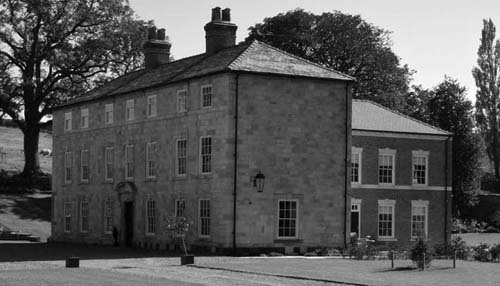
Cadeby Hall, near Ludborough. A private residence, but with a public footpath passing close by.
Along a road at Digby Fen there used to be glowing lights seen in the 1900s. The belief was that these belonged to a coach that was accidentally driven into a bog
and vanished without a trace. A phantom horseman has also said to have been heard laughing along the road just before Scawby. He apparently got the blame when a local man drowned in a lake that used to be there.
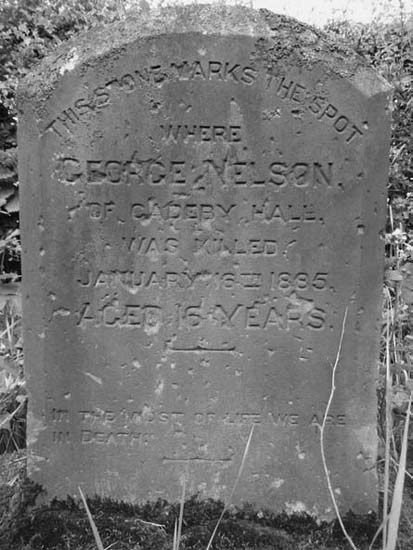
Stone to commemorate sixteen-year-old George Nelson, who was killed on this spot in 1885. It can be seen by the side of the road along the A18 near Ludborough.
At Girsby, a huge ball of fire used to be seen screaming across the road where the body of a pageboy from Girsby Hall was found, skinned alive. It was supposedly his punishment for betraying some robbers who forced him to help them gain access to the hall to steal its goods. However, another version of this story
18
runs that Billy Hooker was the unfortunate post boy, who had been sent on an errand to collect a parcel of money for his employer. Some robbers apparently got word of this and ambushed him on his return. They demanded the money but Billy refused, so the robbers dragged the poor lad down the hill to what became known as Billy’s Hole, where they skinned him alive, draping his skin on the hedge to dry. They ran off with the money, but when they had skinned Billy, they had left the palms of his hands intact and legend has it that this skin grew and grew, eventually re-covering the boy’s body in skin once more. The hedge never recovered, however; it has never been able to grow in the place where Billy’s skin was draped.
The
Lincolnshire Life
magazine reiterates another interesting ghost story involving burning.
19
It is set in the eleventh century at Monksfield Farm in the Fens. It is said a monastic community lived there, but one night there was a terrible fire
and the dormitory was burnt down. Every member of the community died in the fire and every year since, on the anniversary of this tragic event, the ghostly figure of a monk has apparently been seen hurrying across the farmyard with his clothes flaming. It seems that all the locals knew of this ghostly spectre and were very wary of it, but a man called Wellam took the farm over in the nineteenth century and scoffed at the superstition. The tradition had always been to stack the hay in the field but Wellam told the foreman, Glens, he wanted it stacked in the yard from now on. Glens warned him that it would all be burnt, as that was the path along which the flaming monk ran but Wellam didn’t believe the story and insisted. He even bet the foreman £5 that the hay would not be burnt. The anniversary came and went and in the morning Wellam found all the hay in the yard had been burnt to a crisp. At first he suspected Glens, thinking he was after his £5, but when he saw how terrified the man was he soon lost his suspicion. The next year he insisted the hay be stacked there again, and he said this time he would keep watch on the anniversary and stop anyone up to mischief, even the blazing monk. However, the next morning the farm workers found his burned and charred body in the yard. No-one ever knew what he had seen.
Lincolnshire has always been a very important centre of military aviation in this country, especially during the First and Second World Wars. In the First World War, there were thirty-seven military aerodromes and Lincolnshire was also the major centre of aircraft production. There were around one hundred RAF stations in Lincolnshire and one can only imagine the numbers of men involved in those operations. The war was a terrifying time for everyone but that fear must have been greatly increased when flying over enemy territory and having to negotiate enemy fire in the air. Of course, there were many casualties and thus many hauntings have been reported, from phantom sounds of squadrons still flying to people talking to airmen who then simply disappeared from sight. Bruce Barrymore Halpenny has written a series of books entitled
Ghost Stations
and he describes numerous experiences and incidents connected with the ghosts of Lincolnshire’s RAF.
The Dambusters is perhaps one of the most well-known squadrons in the Second World War, and it was formed at RAF Scampton in 1943 for the specific task of attacking three major dams in Germany. The original commander of this squadron, 617, was Guy Gibson. Guy owned a black labrador retriever who became the mascot of the squadron. Unfortunately, later that year the dog was hit by a car and died on the exact day the squadron launched for the attack on the dams.He was buried at RAF Scampton at midnight, outside the window of Guy’s office, as requested by Gibson, and the ghost of the dog is said to haunt the station still. There are stories of a black labrador appearing to guide people who are in trouble, then just disappearing. There have been numerous sightings and his story has become something of a legend. The site of his grave can still be seen and is included in the fascinating and thorough tours of the base, which can be booked by prior arrangement. Also famous as the home of the Red Arrows, the RAF aerobatic team, a tour of RAF Scampton is a must if you are in the area.
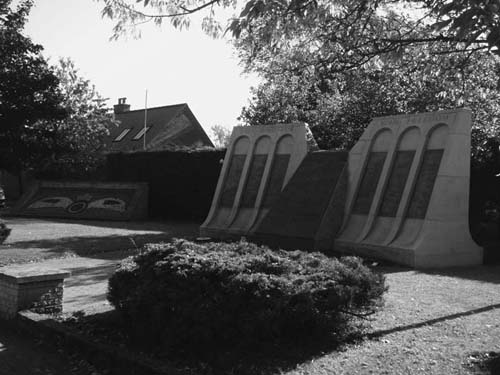
The Dambusters Memorial, Royal Square, Woodhall Spa. Another strange incident tells of a black labrador dog appearing and refusing to move when St Hugh’s School Choir were posing there for a picture. Still seen in the photograph today, the dog disappeared soon after and no one in the village or surrounding area knew whose dog it was or where it had gone.
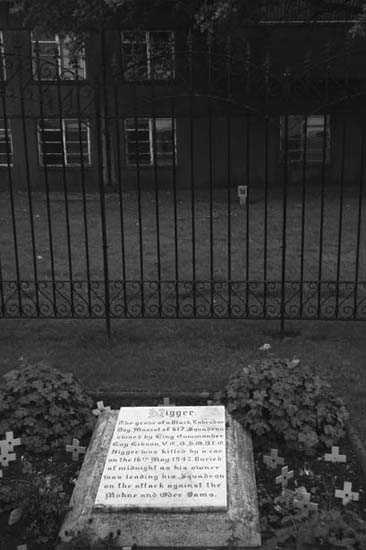
The grave of ‘Nigger’, Guy Gibson’s black labrador dog, whose death was treated as suspicious as it occurred the night squadron 617 were to set out for the Dambusters raid. One theory was that he was murdered, to make the men think their mission would be jinxed. Guy Gibson’s office is the top-right window. Flowers and dog biscuits are placed on his grave every year on the anniversary of this date, and the biscuits are said to have always disappeared by morning!
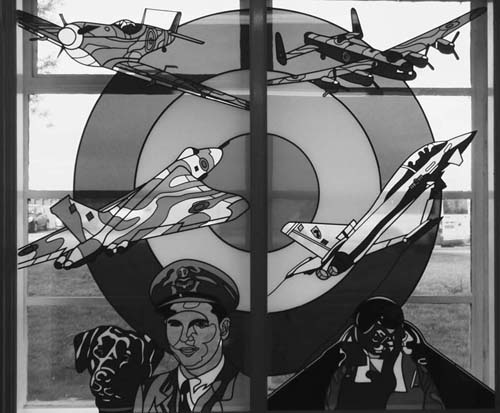
A colourful stained-glass window in the museum on the RAF Scampton air base, depicting Guy and his dog, Nigger.

The Red Arrows at home in their hanger at the RAF base at Scampton.
The Black Bull Inn in Welton was apparently a regular pub for Guy and his squadron, and since their deaths it is said the premises are haunted. The landlord allegedly made some tape recordings of inexplicable noises – doors opening and closing and the sound of footsteps walking slowly up to the restaurant, even though no-one was there.
